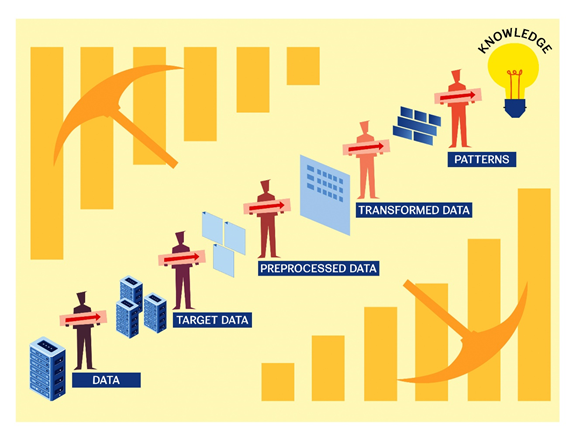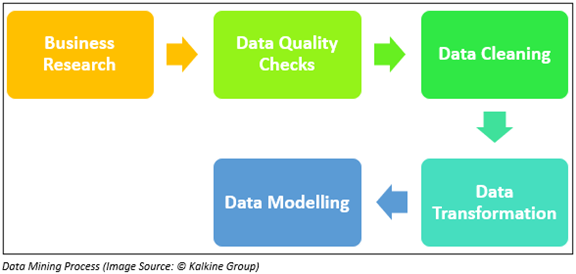Data Mining
Updated on 2023-08-29T11:54:13.669267Z
What is Data Mining?
Data mining is a process that facilitates the extraction of relevant information from a vast dataset. The process helps to discover a new, accurate and useful pattern in the data to derive helpful pattern in data and relevant information from the dataset for organization or individual who requires it.
Key Features of data mining include:
- Based on the trend and behaviour analysis, data mining helps to predict pattern automatically.
- Predicts the possible outcome.
- Helps to create decision-oriented information.
- Focuses on large datasets and databases for analysis.
- Clustering based on findings and a visually documented group of facts that were earlier hidden.
How does data mining work?
- The first step of the data mining process includes the collection of data and loading it into the data warehouse.
- In the next step, the data is stored and managed on cloud or in-house servers.
- Business analyst, data miners, IT professionals or the management team then extracts these data from the sources and accordingly access and determine the way they want to organize the data.
- The application software performs data sorting based on user’s result.
- In the last step, the user presents the data in the presentable format, which could be in the form of a graph or table.
 Image Source: © Kalkine Group 2020
Image Source: © Kalkine Group 2020
What is the process of data mining?
Multiple processes are involved in the implementation of data mining before mining happens. These processes include:
- Business Research: Before we begin the process of data mining, we must have a complete understanding of the business problem, business objectives, the resources available plus the existing scenario to meet these requirements. Having a fair knowledge of these topics would help to create a detailed data mining plan that meets the goals set up by the business.
- Data Quality Checks: Once we have all the data collected, we must check the data so that there are no blockages in the data integration process. The quality assurance helps to detect any core irregularities in the data like missing data interpolation.
- Data Cleaning: A vital process, data cleaning costumes a considerable amount of time in the selection, formatting, and anonymization of data.
- Data Transformation: Once data cleaning completes, the next process involves data transformation. It comprises of five stages comprising, data smoothing, data summary, data generalization, data normalization and data attribute construction.
- Data Modelling: In this process, several mathematical models are implemented in the dataset.

What are the techniques of data mining?
- Association: Association (or the relation technique) is the most used data mining technique. In this technique, the transaction and the relationship between the items are used to discover a pattern. Association is used for market basket analysis which is done to identify all those products which customer buy together. An example of this is a department store, where we find those goods close to each other, which the customers generally buy together, like bread, butter, jam, eggs.
- Clustering: Clustering technique involves the creation of a meaningful object with common characteristics. An example of this is the placement of books in the library in a way that a similar category of books is there on the same shelf.
- Classification: As the name suggests, the classification technique helps the user to classify and variable in the dataset into pre-defined groups and classes. It uses linear programming, statistics, decision tree and artificial neural networks. Through the classification technique, we can develop software that can be modelled so that data can be classified into different classes.
- Prediction: Prediction techniques help to identify the dependent and the independent variables. Based on the past sales data, a business can use this technique to identify how the business would do in the future. It can help the user to determine whether the business would make a profit or not.
- Sequential Pattern: In this technique, the transaction data is used and though this data, the user identifies similar trends, pattern, and events over a period. An example is the historical sales data which a department store pulls out to identify the items in the store which customer purchases together at different times of the year.
Applications of data mining
Data mining techniques find their applications across a broad range of industries. Some of the applications are listed below:
- Healthcare
- Education
- Customer Relationship Management
- Manufacturing
- Market Basket Analysis
- Finance and Banking
- Insurance
- Fraud Detection
- Monitoring Pattern
- Classification
Data Mining Tools
Data mining aims to find out the hidden, valid and all possible patterns in a large dataset. In this process, there are several tools available in the market that helps in data mining. Below is a list of ten of the most widely used data mining tools:
- SAS Data mining
- Teradata
- R-Programing
- Board
- Dundas
- Inetsoft
- H3O
- Qlik
- RapidMiner
- Oracle BI